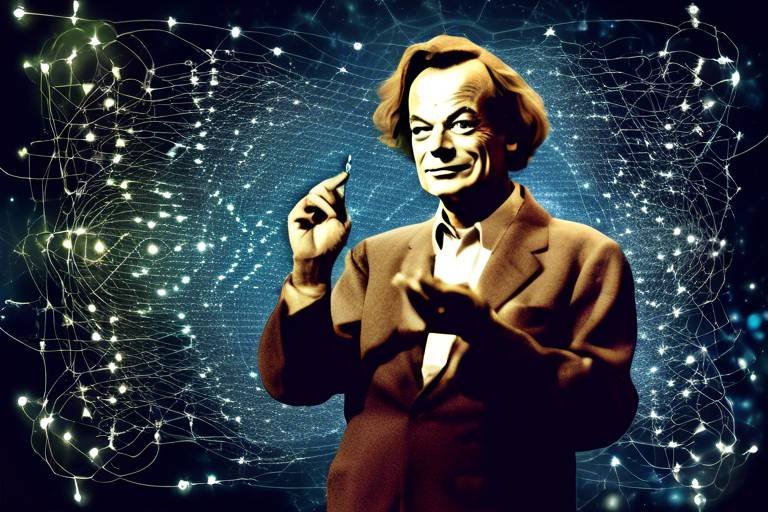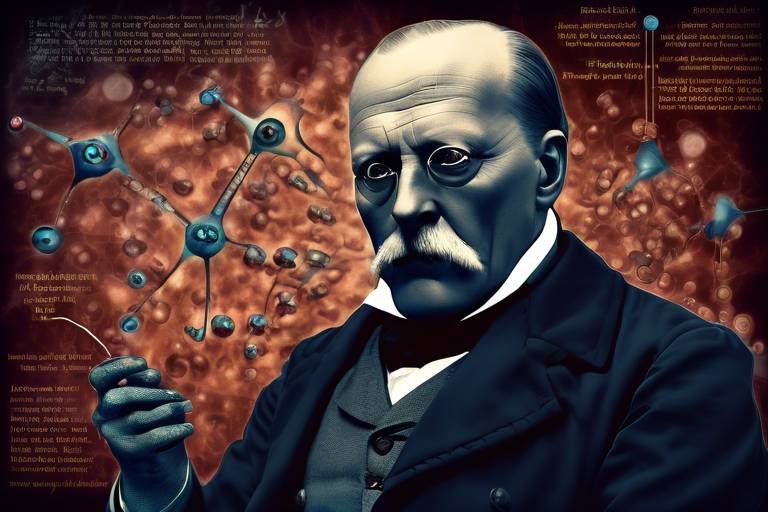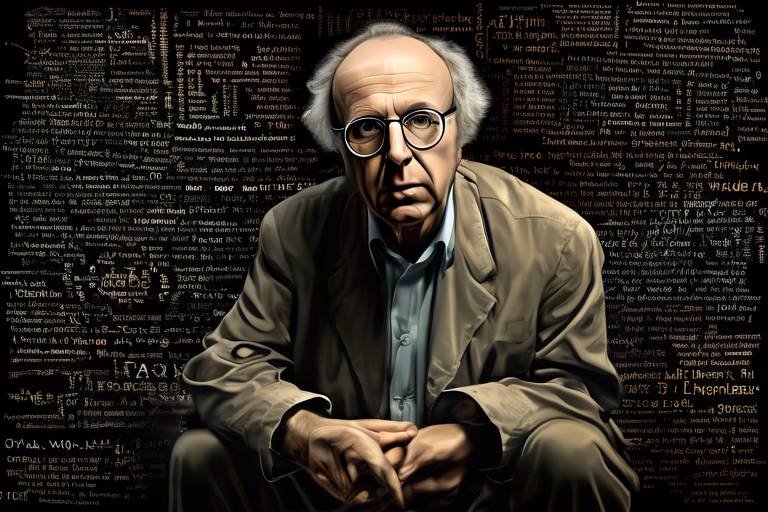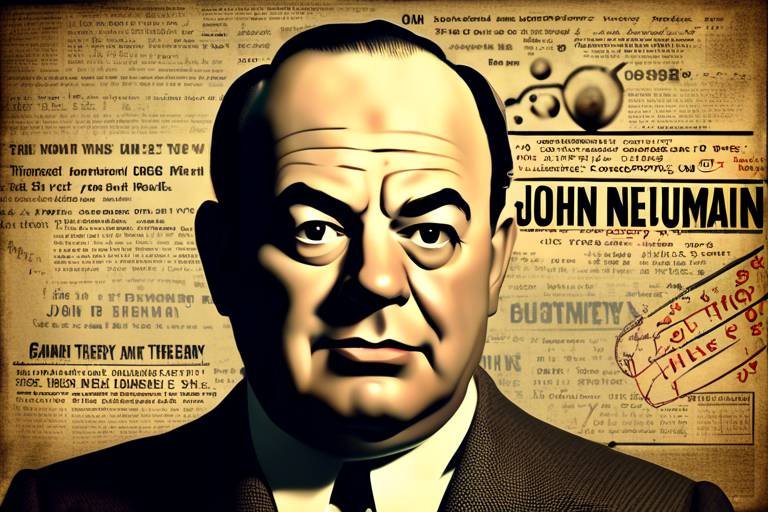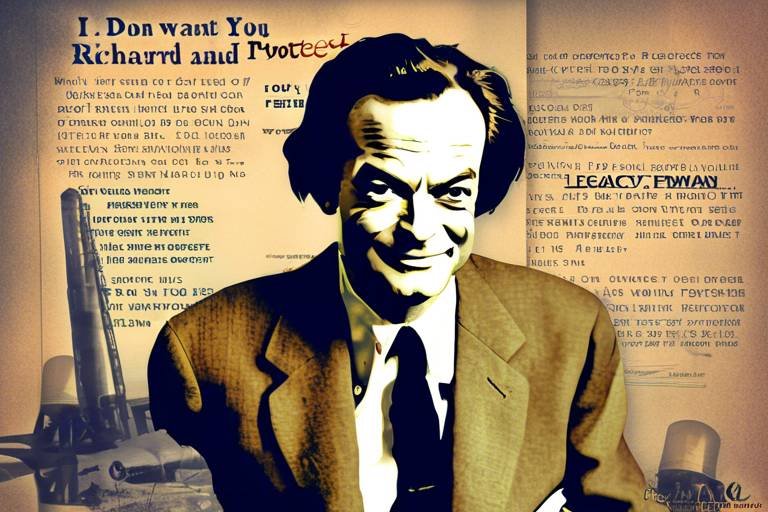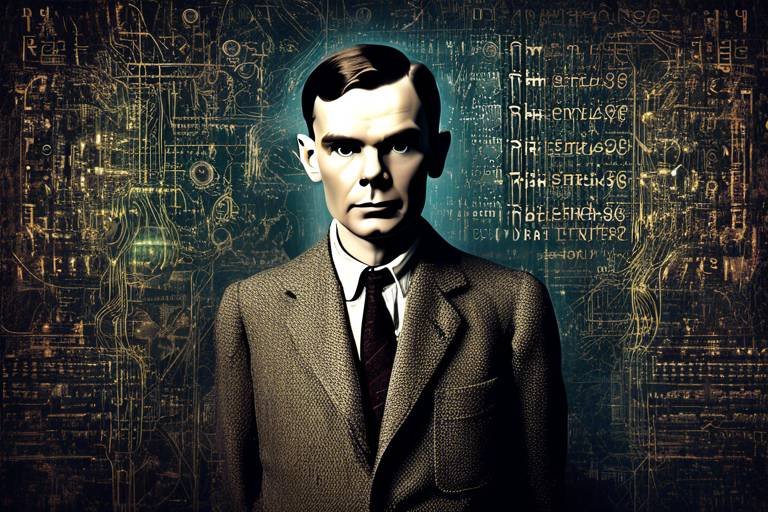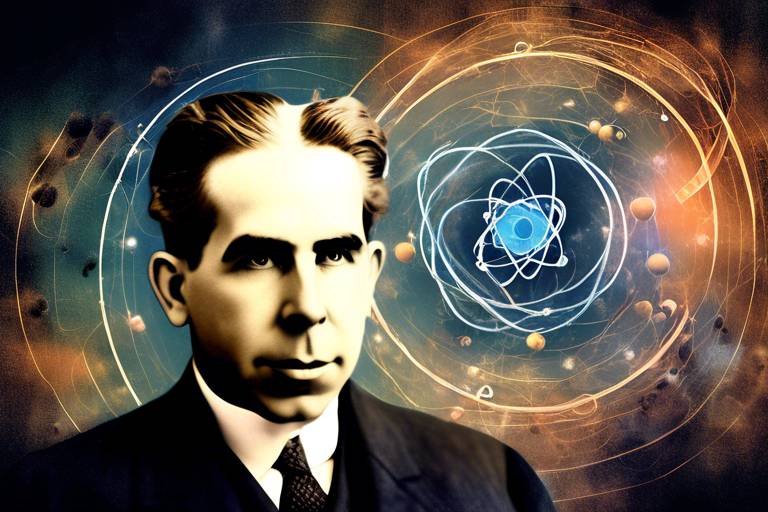The Contributions of Richard Feynman to Quantum Physics
Richard Feynman was not just a physicist; he was a revolutionary thinker whose contributions to quantum physics have left an indelible mark on the field. Born on May 11, 1918, in Queens, New York, Feynman's journey into the world of science began at a young age, driven by a curiosity that was both profound and infectious. His ability to simplify complex ideas and his innovative approaches to theoretical physics transformed how we understand the subatomic world. Feynman's work, particularly in quantum electrodynamics and the introduction of Feynman diagrams, has become foundational in modern physics. But his influence extends far beyond his academic achievements; he was also a passionate educator who inspired countless students to explore the wonders of the universe.
Feynman’s approach was characterized by a deep understanding of the principles of quantum mechanics, coupled with a unique ability to communicate these ideas in a way that resonated with both his peers and the public. His contributions helped bridge the gap between abstract theory and practical application, making quantum physics more accessible. Feynman's legacy is not merely a collection of theories and equations; it is a testament to the power of curiosity and creativity in science. Through his work, he encouraged a generation of physicists to think differently about the universe, to question established norms, and to embrace the unknown.
In this article, we will delve into the various facets of Feynman's contributions to quantum physics, exploring his groundbreaking theories, innovative teaching methods, and the lasting impact he has had on the scientific community. From his early life to his revolutionary ideas in quantum electrodynamics and beyond, Feynman’s journey is a fascinating narrative of exploration and discovery. So, buckle up as we embark on this exciting journey through the life and work of one of the most brilliant minds in physics!
Examining Richard Feynman's early life, education, and experiences that shaped his interest in physics and laid the foundation for his revolutionary ideas in quantum mechanics.
Feynman's formulation of quantum electrodynamics transformed the understanding of light and matter interactions, introducing a new mathematical framework that remains influential in modern physics.
The introduction of Feynman diagrams revolutionized particle physics, providing a visual representation of complex interactions, simplifying calculations, and enhancing communication among physicists.
Feynman diagrams are not just theoretical tools; they have practical applications in various fields, including particle physics, quantum field theory, and even condensed matter physics.
Despite their widespread use, Feynman diagrams have limitations and criticisms, particularly regarding their applicability in non-perturbative situations and for certain complex systems.
Feynman's path integral formulation offered an alternative perspective on quantum mechanics, emphasizing the sum over all possible paths and influencing future research in quantum theory.
Richard Feynman was renowned for his unique and engaging teaching style, which emphasized intuition and understanding over rote memorization, inspiring countless students and scientists.
His famous lectures, compiled into a three-volume series, remain a cornerstone of physics education, making complex concepts accessible to students worldwide.
Feynman's influence extends beyond his lifetime, as his ideas and teaching methods continue to inspire new generations of physicists and educators in the field of quantum mechanics.
- What is Quantum Electrodynamics (QED)?
Quantum Electrodynamics is the quantum field theory that describes how light and matter interact, and it is fundamental to understanding electromagnetic interactions.
- How did Feynman contribute to particle physics?
Feynman introduced diagrams that allowed physicists to visualize and calculate particle interactions, making complex processes easier to understand.
- What is the significance of the Feynman Lectures on Physics?
The Feynman Lectures are a comprehensive introduction to physics, known for their clarity and engaging style, making them a valuable resource for students and educators alike.

Feynman's Path to Quantum Physics
Richard Feynman's journey into the fascinating world of quantum physics began in the bustling town of Far Rockaway, New York, where he was born on May 11, 1918. Growing up in a family that valued education, Feynman was exposed to science and mathematics from an early age. His father, a schoolteacher, often encouraged him to ask questions and explore the world around him. This nurturing environment sparked a curiosity that would eventually lead him to become one of the most influential physicists of the 20th century.
Feynman's educational path was marked by a series of significant milestones. He attended the Massachusetts Institute of Technology (MIT), where he earned his bachelor's degree in physics in 1939. During his time at MIT, he was captivated by the complexities of quantum mechanics, which was still a relatively new field. His inquisitive nature drove him to delve deeper into the subject, and he quickly became known for his innovative thinking and problem-solving skills. After completing his undergraduate studies, Feynman pursued graduate work at Princeton University, where he earned his Ph.D. in 1942. His doctoral thesis, which focused on the principles of quantum mechanics, laid the groundwork for his later contributions to the field.
Feynman's experiences during World War II also played a pivotal role in shaping his scientific career. He worked on the Manhattan Project, contributing to the development of the atomic bomb. This experience not only honed his technical skills but also exposed him to the ethical dilemmas associated with scientific research. After the war, Feynman returned to academia, where he began to develop his revolutionary ideas in quantum physics.
Throughout his career, Feynman was known for his unconventional approach to problem-solving. He often employed a playful attitude towards physics, viewing it as a puzzle to be solved rather than a rigid set of rules. This perspective allowed him to challenge existing paradigms and propose new theories that would ultimately reshape our understanding of the quantum world. His unique blend of creativity and analytical thinking made him a standout figure in the scientific community, and his contributions to quantum mechanics would leave a lasting legacy.
In summary, Richard Feynman's path to quantum physics was marked by a combination of early curiosity, rigorous education, and groundbreaking experiences. His journey not only shaped his own career but also paved the way for future generations of physicists. As we delve deeper into his contributions, we will uncover how his innovative theories and teaching methods continue to influence the field of quantum physics today.

Quantum Electrodynamics (QED)
Quantum Electrodynamics, or QED, is a fascinating field that reshaped our understanding of the interactions between light and matter. Imagine a world where particles can dance and interact in ways we never thought possible—this is the essence of QED. Developed by Richard Feynman, QED is not just a theory; it's a comprehensive framework that describes how photons (the particles of light) and charged particles, like electrons, interact. This interaction is fundamental to many aspects of physics and technology, from the way lasers work to the principles behind modern electronics.
Feynman's work in QED was groundbreaking. He introduced a new mathematical formulation that provided clarity and precision to the previously murky waters of quantum mechanics. Before QED, physicists struggled with the complexities of electromagnetic interactions, often leading to inconsistent results. Feynman's innovative approach allowed scientists to calculate probabilities of various interactions with unprecedented accuracy, effectively bridging the gap between quantum mechanics and classical physics.
One of the most revolutionary aspects of QED is the introduction of Feynman diagrams. These diagrams serve as a visual representation of particle interactions, making the complex calculations of quantum physics more accessible. Picture a web of lines and vertices—each line represents a particle, and each vertex represents an interaction. This simple yet powerful tool transformed the way physicists communicate and calculate interactions in particle physics. Instead of delving into complicated equations, scientists can now sketch a diagram and extract meaningful information, simplifying the entire process.
Feynman diagrams are not just theoretical constructs; they have practical applications across various fields of physics. Here are a few notable applications:
- Particle Physics: Feynman diagrams are essential in predicting outcomes of high-energy particle collisions, such as those conducted at CERN's Large Hadron Collider.
- Quantum Field Theory: They provide a framework for understanding interactions in quantum field theories, helping physicists visualize complex processes.
- Condensed Matter Physics: Feynman diagrams are utilized to analyze interactions in solid-state systems, aiding in the development of new materials.
Despite their widespread use, Feynman diagrams are not without limitations. Critics argue that they may not be applicable in non-perturbative situations, where interactions are too strong or complex to be represented accurately. Additionally, for certain systems, the diagrams can become unwieldy and less intuitive. However, even with these criticisms, the impact of Feynman diagrams on the field of physics cannot be overstated—they remain a cornerstone in our understanding of quantum interactions.
Feynman's path integral formulation further enriched the landscape of quantum mechanics. This approach emphasizes the idea of summing over all possible paths a particle can take, rather than focusing on a single trajectory. It's like imagining a traveler who could take countless routes to reach a destination, each path contributing to the final outcome. This perspective not only provided deeper insights into quantum behavior but also influenced future research, paving the way for new theories and discoveries in quantum physics.

Feynman Diagrams
When we think about the world of particle physics, it often feels like stepping into a complex maze filled with abstract concepts and intricate calculations. Enter , the brilliant brainchild of Richard Feynman that transformed this maze into a more navigable landscape. These diagrams are not just pretty pictures; they are powerful visual tools that capture the interactions between particles in a way that is both intuitive and insightful. Imagine trying to explain a bustling marketplace with just words—confusing, right? Now, picture drawing a map that shows how people move, interact, and exchange goods. That’s what Feynman diagrams do for particle interactions.
At their core, Feynman diagrams represent the paths taken by particles as they interact with one another. Each line in these diagrams corresponds to a particle, while the points where lines meet signify interactions, such as the emission or absorption of particles. This visual representation simplifies the complex mathematics involved in quantum electrodynamics (QED) and makes it easier for physicists to communicate intricate ideas. In essence, they provide a common language, bridging gaps between different areas of physics and fostering collaboration.
To truly appreciate the impact of Feynman diagrams, let’s break down their significance:
- Visual Clarity: They transform abstract mathematical equations into a visual format, making it easier to grasp the underlying physics.
- Calculation Simplification: Feynman diagrams allow physicists to perform calculations more efficiently, often reducing complex integrals into simpler forms.
- Enhanced Communication: With a universal visual language, physicists can share ideas and findings without getting lost in technical jargon.
However, while Feynman diagrams are immensely useful, they are not without limitations. For instance, they excel in perturbative calculations, where interactions can be treated as small deviations from a known solution. But what about those situations where interactions are strong and non-perturbative? Here, the diagrams can fall short, leaving physicists needing to explore alternative approaches. It’s a bit like trying to use a hammer for every job; sometimes, you need a different tool to get the job done right.
In summary, Feynman diagrams are a revolutionary development in the toolkit of physicists. They provide a bridge between the abstract world of quantum mechanics and the tangible realm of visual representation, making complex interactions more approachable. As we delve deeper into the universe's mysteries, these diagrams will undoubtedly remain a cornerstone of particle physics, illuminating paths that were once obscured by mathematical complexity.

Applications of Feynman Diagrams
Feynman diagrams are not merely theoretical constructs; they have become essential tools in various branches of physics, facilitating a deeper understanding of complex interactions. These diagrams serve as a bridge between abstract mathematical formulations and tangible physical phenomena, making them invaluable in both theoretical and experimental physics. Their applications extend far beyond the realm of quantum electrodynamics, impacting multiple fields.
One of the primary applications of Feynman diagrams is in particle physics, where they help physicists visualize and calculate interactions between particles. For instance, when studying high-energy collisions in particle accelerators, Feynman diagrams provide a clear representation of the processes involved, such as the creation and annihilation of particles. This visual aid significantly simplifies the calculations required to predict outcomes from these interactions.
In addition to particle physics, Feynman diagrams are also employed in quantum field theory. They allow researchers to tackle complex problems involving multiple particles and interactions in a systematic way. By representing interactions graphically, these diagrams help physicists understand the underlying principles of the forces at play. For example, they can illustrate the exchange of virtual particles, which are crucial for mediating forces between real particles.
Furthermore, Feynman diagrams have found applications in condensed matter physics. In this field, they are used to analyze phenomena such as superconductivity and quantum phase transitions. The ability to represent interactions in a visual format helps scientists to explore emergent behaviors in complex systems, making it easier to communicate ideas and findings within the scientific community.
While the utility of Feynman diagrams is clear, it is essential to recognize that they are not without limitations. In certain scenarios, particularly in non-perturbative situations or when dealing with complex systems that cannot be easily approximated, Feynman diagrams may fall short. Nonetheless, their widespread use across various domains of physics highlights their significance and the profound impact Richard Feynman had on the field.
In conclusion, Feynman diagrams have transcended their original purpose in quantum electrodynamics to become fundamental tools in numerous areas of physics. Their ability to simplify complex interactions and enhance communication among scientists demonstrates their lasting legacy in the world of physics.
- What are Feynman diagrams?
Feynman diagrams are graphical representations of interactions between particles in quantum field theory, used to simplify complex calculations and visualize processes.
- How do Feynman diagrams help in particle physics?
They provide a clear visual representation of particle interactions, making it easier to calculate probabilities and predict outcomes in high-energy collisions.
- Can Feynman diagrams be used outside of quantum electrodynamics?
Yes, they are widely used in particle physics, quantum field theory, and condensed matter physics to analyze various interactions and phenomena.
- What are some limitations of Feynman diagrams?
They may not be effective in non-perturbative situations or for complex systems that cannot be easily approximated using perturbation theory.

Criticism and Limitations
While Feynman diagrams have been a game-changer in the realm of particle physics, they are not without their critics. Some physicists argue that these diagrams can be misleading, particularly when applied to complex systems where interactions are not easily visualized. The beauty of a diagram can sometimes obscure the underlying mathematical intricacies that govern particle behavior.
One of the primary criticisms revolves around the perturbative approach that Feynman diagrams rely on. This method assumes that interactions can be treated as small perturbations around a known solution. However, in many cases, especially in strong coupling scenarios, this assumption falls apart. For instance, in quantum chromodynamics (QCD), the theory that describes the strong interaction, the perturbative approach struggles to yield accurate predictions, leading to significant discrepancies between theoretical results and experimental data.
Moreover, Feynman diagrams, while visually appealing, can sometimes give a false sense of completeness. They are essentially a shorthand for complex mathematical expressions, and relying solely on them can lead to oversimplifications. As a physicist, one must remember that these diagrams are just tools—powerful tools, but tools nonetheless. They do not encompass the entirety of quantum interactions, particularly in non-perturbative regimes where the behavior of particles can be vastly different.
Another limitation is that Feynman diagrams are not universally applicable to all areas of physics. In fields such as condensed matter physics, where many-body interactions dominate, the utility of these diagrams diminishes. The complexity of interactions in these systems often requires more sophisticated approaches that go beyond what Feynman diagrams can provide.
In summary, while Feynman diagrams have undoubtedly transformed our understanding of particle interactions, it is crucial to approach them with a critical eye. They are invaluable for many applications but come with limitations that researchers must navigate carefully. The dialogue around their use continues to evolve, reflecting the dynamic nature of quantum physics itself.
- What are Feynman diagrams? Feynman diagrams are pictorial representations of particle interactions, allowing physicists to calculate probabilities and visualize complex processes in quantum mechanics.
- Why are Feynman diagrams important? They simplify calculations in quantum electrodynamics and particle physics, making it easier to understand interactions between particles.
- What are the limitations of Feynman diagrams? They can be misleading in complex systems, rely on perturbative methods that may not apply in strong coupling scenarios, and are not universally applicable across all areas of physics.
- How do Feynman diagrams relate to quantum mechanics? They provide a visual and mathematical framework for understanding quantum interactions, contributing to the development of quantum field theory.

Path Integral Formulation
The path integral formulation of quantum mechanics, introduced by Richard Feynman, represents a significant shift in how we understand the behavior of particles at the quantum level. Rather than viewing particles as following a single, deterministic path, Feynman's approach suggests that particles can take an infinite number of paths to reach their destination. This revolutionary idea not only reshaped theoretical physics but also provided a more intuitive way to think about quantum phenomena. Imagine a traveler trying to reach a destination; instead of taking one road, they explore every possible route, each contributing to their final position. This is the essence of Feynman's path integral formulation.
At its core, the formulation posits that the probability amplitude of a particle moving from one point to another is calculated by summing over all possible paths it could take. This means that every conceivable trajectory contributes to the final outcome, weighted by a factor that depends on the action associated with each path. The action, a central concept in physics, is a quantity that encapsulates the dynamics of a system. In this framework, the more 'natural' paths—those that minimize the action—contribute most significantly to the probability amplitude, while less likely paths have a diminishing effect.
Feynman's path integral approach not only provided a new way to look at quantum mechanics but also had profound implications for various fields of physics. It paved the way for advancements in areas such as quantum field theory, where the interactions of particles can be modeled more effectively. Furthermore, it has influenced other disciplines, including statistical mechanics and even cosmology. The ability to visualize quantum processes through this framework has made it easier for physicists to communicate complex ideas and collaborate across different areas of research.
However, like all groundbreaking theories, the path integral formulation is not without its challenges. While it works exceptionally well in many scenarios, there are limitations, especially in non-perturbative contexts where traditional methods may falter. To illustrate this, consider a scenario where the forces at play are too complex to be broken down into simpler interactions. In such cases, the path integral approach may struggle to provide clear insights, highlighting the need for continued exploration and refinement of Feynman's ideas.
In summary, Feynman's path integral formulation has transformed quantum mechanics, offering a rich and flexible framework that continues to inspire physicists today. Its emphasis on the myriad possibilities inherent in quantum behavior captures the imagination and challenges our understanding of reality itself. As we delve deeper into the mysteries of the universe, Feynman's legacy lives on, reminding us that the journey of discovery is often as important as the destination.
- What is the path integral formulation?
The path integral formulation is a method in quantum mechanics that sums over all possible paths a particle can take to calculate probability amplitudes. - How did Feynman's path integral formulation change physics?
It provided a new perspective on quantum mechanics, allowing for a more intuitive understanding of particle interactions and influencing various fields like quantum field theory. - What are the limitations of the path integral formulation?
While powerful, it may struggle in non-perturbative situations where traditional methods are more effective. - Can the path integral formulation be applied to other fields?
Yes, it has applications in statistical mechanics, cosmology, and other areas of physics.

Feynman's Teaching Philosophy
Richard Feynman was not just a brilliant physicist; he was also an extraordinary teacher. His teaching philosophy was rooted in the belief that understanding should come before memorization. Feynman often emphasized that true learning involves grasping the underlying principles rather than simply regurgitating facts. He famously said, "The first principle is that you must not fool yourself—and you are the easiest person to fool." This mindset encouraged students to question their own assumptions and think critically about complex topics.
One of the hallmarks of Feynman's teaching style was his ability to make difficult concepts approachable. He had a unique talent for breaking down intricate theories into digestible pieces, often using analogies and real-world examples to illustrate his points. For instance, he would compare the behavior of electrons to a game of chess, where each piece has its own set of rules and interactions, helping students visualize the abstract nature of quantum mechanics.
Feynman's lectures were not just about delivering information; they were performances that engaged students on a deeper level. His enthusiasm for physics was infectious, and he often used humor and storytelling to captivate his audience. This engaging style made learning feel less like a chore and more like an exciting adventure into the mysteries of the universe. In fact, many students who attended his lectures often describe them as transformative experiences that ignited their passion for science.
One of his most significant contributions to education is encapsulated in The Feynman Lectures on Physics, a three-volume series that has become a classic in the field. These lectures were designed to challenge students to think independently and creatively. Feynman believed that students should not only learn the material but also understand how to apply it in various contexts. The series covers a wide range of topics and remains a go-to resource for students and educators alike, bridging the gap between theory and practical application.
In addition to his engaging teaching methods, Feynman also emphasized the importance of curiosity. He encouraged his students to ask questions and explore the unknown. This approach fostered a learning environment where students felt comfortable expressing their thoughts and engaging in discussions. Feynman understood that the best way to learn is through inquiry and exploration, and he often said, "If you want to find out anything from the theoretical physics point of view, you should try to think of it in terms of the simplest possible model."
Feynman's influence on education extends far beyond his classroom. His philosophy has inspired countless educators to adopt similar methods, focusing on fostering a love for learning rather than just teaching to the test. By prioritizing understanding and curiosity, Feynman has left a lasting legacy in the world of education, encouraging future generations of physicists to think critically and creatively.
In conclusion, Richard Feynman's teaching philosophy was a blend of intuition, enthusiasm, and a deep commitment to fostering understanding. His innovative methods not only transformed the way physics is taught but also inspired a generation of scientists to approach their studies with curiosity and a desire to explore the unknown. The impact of his teachings continues to resonate in classrooms around the world, making physics accessible and exciting for all.
- What made Feynman's teaching style unique? Feynman's teaching style was unique due to his emphasis on understanding over memorization, his use of analogies, and his engaging storytelling techniques.
- How did Feynman's lectures influence students? His lectures inspired students by making complex concepts approachable and exciting, often igniting a passion for physics that lasted a lifetime.
- What are The Feynman Lectures on Physics? The Feynman Lectures on Physics is a three-volume series that compiles Feynman's lectures, designed to make physics accessible and engaging for students.
- Why is curiosity important in learning according to Feynman? Feynman believed that curiosity drives inquiry and exploration, which are essential for deep understanding and innovative thinking in science.

The Feynman Lectures on Physics
Richard Feynman's lectures have become legendary in the world of physics education. Compiled into a three-volume series, provide a unique blend of insight, humor, and clarity that captivates audiences. Feynman had a remarkable ability to break down complicated concepts into digestible pieces, making physics not just accessible but also incredibly engaging. Imagine sitting in a lecture hall, where the professor not only explains the laws of physics but also shares stories, jokes, and real-world applications that breathe life into the subject.
One of the key features of these lectures is Feynman's emphasis on understanding over memorization. He believed that true learning occurs when students grasp the underlying principles rather than merely recalling formulas. This approach is exemplified in his discussions about fundamental topics such as electromagnetism and quantum mechanics, where he often used analogies and thought experiments to illustrate complex ideas. For instance, Feynman famously compared the behavior of electrons to that of a dancer, moving fluidly and unpredictably, which helps students visualize abstract concepts.
Moreover, the lectures are not just a one-way street; they invite students to think critically and ask questions. Feynman often posed rhetorical questions to challenge his audience, encouraging them to explore the 'why' behind physical phenomena. This interactive style fosters a deeper connection with the material, prompting students to engage actively rather than passively absorb information.
To further enhance understanding, Feynman incorporated visual aids and demonstrations into his lectures. He was known for his ability to draw diagrams on the spot, illustrating points that would otherwise be difficult to convey through words alone. This visual representation is particularly effective in physics, where many concepts are inherently abstract. As a result, students often found themselves not just learning physics but experiencing it.
In addition to the content, the structure of is thoughtfully designed. Each volume covers different aspects of physics, from mechanics to electromagnetism and quantum mechanics. Here’s a brief overview of the volumes:
| Volume | Title | Focus Area |
|---|---|---|
| 1 | The Feynman Lectures on Physics: Volume I | Mechanics, Radiation, and Heat |
| 2 | The Feynman Lectures on Physics: Volume II | Electromagnetism and Matter |
| 3 | The Feynman Lectures on Physics: Volume III | Quantum Mechanics |
These volumes serve not only as textbooks but also as a source of inspiration for students and educators alike. They are often recommended for anyone looking to grasp the beauty and intricacies of physics. Even those who are not pursuing a career in science can find joy in Feynman's ability to convey the wonder of the universe.
Ultimately, the impact of extends far beyond the classroom. They have become a staple in physics education, influencing countless educators and students. Feynman's legacy lives on, reminding us that physics is not just a collection of equations but a way to understand the world around us. His engaging style and profound insights continue to inspire new generations of physicists, making the complex world of quantum mechanics feel a little less daunting and a lot more exciting.
- What are The Feynman Lectures on Physics? They are a series of lectures given by Richard Feynman, compiled into three volumes covering various topics in physics.
- Why are these lectures significant? They emphasize understanding over memorization, making complex concepts accessible and engaging.
- Can anyone benefit from these lectures? Absolutely! They are designed for both students and anyone interested in learning about physics.

Impact on Future Generations
Richard Feynman's legacy is not just a collection of theories and equations; it is a vibrant tapestry that continues to inspire and shape the minds of future generations. His unique approach to teaching and his ability to convey complex concepts in a relatable manner have made him a beacon for students and educators alike. Imagine walking into a classroom where physics is not just a subject but an adventure full of wonder and discovery—that’s the Feynman effect!
One of the most significant aspects of Feynman's impact can be seen in the way he emphasized curiosity and intuitive understanding. He believed that true learning happens when students engage with the material, ask questions, and explore ideas rather than simply memorizing facts. This philosophy has permeated educational practices, encouraging teachers to adopt more interactive and student-centered methodologies. As a result, classrooms around the world are buzzing with excitement rather than stifled by traditional rote learning.
Moreover, Feynman’s Lectures on Physics have become a staple in physics education. These lectures, compiled into a three-volume series, serve as an invaluable resource for students and educators. They are not just textbooks; they are a gateway into the fascinating world of physics that invites readers to think critically and explore the universe’s mysteries. Many educators cite these lectures as a source of inspiration, using them to ignite a passion for science in their students.
Feynman’s influence also stretches into the realm of research and scientific inquiry. His innovative ideas have paved the way for new fields of study and have inspired countless physicists to push the boundaries of knowledge. The path integral formulation, for instance, has opened new avenues in quantum mechanics, leading to advances in areas such as quantum computing and nanotechnology. The ripple effect of his work is evident in the ongoing research and discoveries that continue to unfold.
Feynman was not just a physicist; he was a communicator and a storyteller. His ability to articulate the beauty and intricacies of physics in a way that resonates with people from all walks of life has made science more accessible. This accessibility is crucial in today’s world, where scientific literacy is more important than ever. As we face global challenges such as climate change and public health crises, the ability to communicate scientific ideas effectively can lead to informed decision-making and a more educated public.
In conclusion, Richard Feynman’s impact on future generations is profound and far-reaching. His innovative teaching methods, engaging lectures, and groundbreaking research have left an indelible mark on the field of physics and education. As future physicists and educators draw inspiration from his work, they carry forward his legacy of curiosity, creativity, and a relentless pursuit of knowledge. The world of science is indeed a brighter place because of Feynman, and his influence will continue to be felt for many years to come.
- What is Richard Feynman best known for? Feynman is best known for his work in quantum electrodynamics and his unique teaching style that emphasizes understanding over memorization.
- How did Feynman contribute to education? He contributed to education through his engaging lectures and books, which have made complex physics concepts accessible to students worldwide.
- What are Feynman diagrams? Feynman diagrams are a graphical representation of particle interactions in quantum field theory, simplifying complex calculations.
- Why are Feynman's lectures still relevant today? Feynman's lectures remain relevant because they inspire curiosity and critical thinking, essential skills for students in any scientific field.
Frequently Asked Questions
- What were Richard Feynman's major contributions to quantum physics?
Richard Feynman made several groundbreaking contributions to quantum physics, most notably his formulation of quantum electrodynamics (QED) and the introduction of Feynman diagrams. His work transformed the understanding of light and matter interactions, providing a new mathematical framework that is still influential today.
- How did Feynman diagrams change the field of particle physics?
Feynman diagrams revolutionized particle physics by offering a visual representation of complex interactions among particles. They simplified calculations and enhanced communication among physicists, making it easier to conceptualize and analyze particle interactions in a more intuitive way.
- What is the significance of Feynman's path integral formulation?
Feynman's path integral formulation presents an alternative perspective on quantum mechanics by emphasizing the sum over all possible paths a particle can take. This approach has influenced future research and has provided deep insights into the nature of quantum phenomena.
- Why are The Feynman Lectures on Physics considered essential?
The Feynman Lectures on Physics are considered essential because they make complex concepts accessible and engaging for students. Feynman's unique teaching style emphasized intuition and understanding, inspiring countless individuals to delve into the world of physics.
- What criticisms exist regarding Feynman diagrams?
Despite their widespread use, Feynman diagrams are not without criticism. They have limitations, particularly in non-perturbative situations and for certain complex systems where their applicability may not hold, leading to debates about their overall effectiveness in all scenarios.
- How has Richard Feynman's legacy influenced future generations of physicists?
Richard Feynman's legacy continues to inspire new generations of physicists and educators. His innovative ideas and engaging teaching methods have left a lasting impact on the field of quantum mechanics, encouraging students to think critically and creatively about complex scientific concepts.

